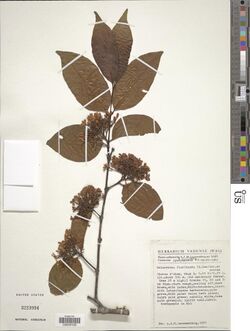Biology:Holarrhena floribunda
| Holarrhena floribunda | |
|---|---|

| |
| Scientific classification | |
| Kingdom: | Plantae |
| Clade: | Tracheophytes |
| Clade: | Angiosperms |
| Clade: | Eudicots |
| Clade: | Asterids |
| Order: | Gentianales |
| Family: | Apocynaceae |
| Genus: | Holarrhena |
| Species: | H. floribunda
|
| Binomial name | |
| Holarrhena floribunda | |
| Synonyms[2] | |
| |
Holarrhena floribunda, commonly known as the false rubber tree, conessi bark or kurchi bark,[3] is a plant in the family Apocynaceae.
Description
Holarrhena floribunda grows as a shrub or tree up to 25 metres (82 ft) tall, with a stem diameter of up to 30 centimetres (12 in). Its fragrant flowers feature a white corolla. The fruit is pale grey to dark brown with paired follicles, each up to 60 centimetres (24 in) long.[4]
Distribution and habitat
Holarrhena floribunda is found in a variety of habitats from sea-level to 1,000 metres (3,300 ft) altitude.[4] The plant is native to a wide range of West and Central Africa from Senegal to Angola.[1]
Uses
Holarrhena floribunda is locally used in traditional medicine as a treatment for dysentery, diarrhoea, fever, snakebite, infertility, venereal disease, diabetes and malaria. The plant has been used as arrow poison.[4]
References
- ↑ Jump up to: 1.0 1.1 Botanic Gardens Conservation International (BGCI).; IUCN SSC Global Tree Specialist Group (2019). "Holarrhena floribunda". IUCN Red List of Threatened Species 2019: e.T144299547A149056176. doi:10.2305/IUCN.UK.2019-2.RLTS.T144299547A149056176.en. https://www.iucnredlist.org/species/144299547/149056176. Retrieved 19 November 2021.
- ↑ Jump up to: 2.0 2.1 "Holarrhena floribunda". World Checklist of Selected Plant Families (WCSP). Royal Botanic Gardens, Kew. http://wcsp.science.kew.org/qsearch.do?page=quickSearch&plantName=Holarrhena%2Bfloribunda.
- ↑ {{citation | mode = cs1 | title = Holarrhena floribunda | work = Germplasm Resources Information Network (GRIN) | url = | publisher = [[Organization:Agricultural Research ServAgricultural Research Service (ARS), United States Department of Agriculture (USDA) | access-date = 22 April 2020 }}
- ↑ Jump up to: 4.0 4.1 4.2 Medicinal Plants. PROTA. 2008. pp. 329–332. ISBN 978-9-05782-204-9.
External links
Wikidata ☰ Q14860444 entry
 |


